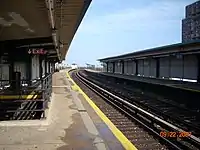Beach 60 Street | ||||||||||||||||||||||||||||||||||||||||||||||||||||||||||||||||||||
|---|---|---|---|---|---|---|---|---|---|---|---|---|---|---|---|---|---|---|---|---|---|---|---|---|---|---|---|---|---|---|---|---|---|---|---|---|---|---|---|---|---|---|---|---|---|---|---|---|---|---|---|---|---|---|---|---|---|---|---|---|---|---|---|---|---|---|---|---|
 Southbound platform | ||||||||||||||||||||||||||||||||||||||||||||||||||||||||||||||||||||
| Station statistics | ||||||||||||||||||||||||||||||||||||||||||||||||||||||||||||||||||||
| Address | Beach 60th Street & Rockaway Freeway Queens, NY 11692 | |||||||||||||||||||||||||||||||||||||||||||||||||||||||||||||||||||
| Borough | Queens | |||||||||||||||||||||||||||||||||||||||||||||||||||||||||||||||||||
| Locale | Arverne | |||||||||||||||||||||||||||||||||||||||||||||||||||||||||||||||||||
| Coordinates | 40°35′33″N 73°47′19″W / 40.592395°N 73.788536°W | |||||||||||||||||||||||||||||||||||||||||||||||||||||||||||||||||||
| Division | B (IND, formerly LIRR Far Rockaway Branch)[1] | |||||||||||||||||||||||||||||||||||||||||||||||||||||||||||||||||||
| Line | IND Rockaway Line | |||||||||||||||||||||||||||||||||||||||||||||||||||||||||||||||||||
| Services | A | |||||||||||||||||||||||||||||||||||||||||||||||||||||||||||||||||||
| Transit | ||||||||||||||||||||||||||||||||||||||||||||||||||||||||||||||||||||
| Structure | Elevated | |||||||||||||||||||||||||||||||||||||||||||||||||||||||||||||||||||
| Platforms | 2 side platforms | |||||||||||||||||||||||||||||||||||||||||||||||||||||||||||||||||||
| Tracks | 2 | |||||||||||||||||||||||||||||||||||||||||||||||||||||||||||||||||||
| Other information | ||||||||||||||||||||||||||||||||||||||||||||||||||||||||||||||||||||
| Opened | 1892 (LIRR station) | |||||||||||||||||||||||||||||||||||||||||||||||||||||||||||||||||||
| Rebuilt | June 28, 1956 (as a Subway station) | |||||||||||||||||||||||||||||||||||||||||||||||||||||||||||||||||||
| Opposite- direction transfer | Yes | |||||||||||||||||||||||||||||||||||||||||||||||||||||||||||||||||||
| Former/other names | Beach 60th Street–Straiton Avenue | |||||||||||||||||||||||||||||||||||||||||||||||||||||||||||||||||||
| Traffic | ||||||||||||||||||||||||||||||||||||||||||||||||||||||||||||||||||||
| 2022 | 349,205[2] | |||||||||||||||||||||||||||||||||||||||||||||||||||||||||||||||||||
| Rank | 405 out of 423[2] | |||||||||||||||||||||||||||||||||||||||||||||||||||||||||||||||||||
| ||||||||||||||||||||||||||||||||||||||||||||||||||||||||||||||||||||
| ||||||||||||||||||||||||||||||||||||||||||||||||||||||||||||||||||||
| ||||||||||||||||||||||||||||||||||||||||||||||||||||||||||||||||||||
| ||||||||||||||||||||||||||||||||||||||||||||||||||||||||||||||||||||
| ||||||||||||||||||||||||||||||||||||||||||||||||||||||||||||||||||||
| ||||||||||||||||||||||||||||||||||||||||||||||||||||||||||||||||||||
The Beach 60th Street station (signed as Beach 60th Street–Straiton Avenue station) is a station on the IND Rockaway Line of the New York City Subway. Located in Queens on the Rockaway Freeway at Beach 60th Street, it is served by the A train at all times. The station opened in 1892, and was rebuilt in 1942 as an elevated station.
History


Beach 60th Street–Straiton Avenue was originally built by the Long Island Rail Road along the Rockaway Beach Branch as Straiton Avenue, also known as Arverne–Straiton Avenue in 1892 as part of a quarrel between the LIRR and New York lawyer and developer Remington Vernam over the original Arverne station on Gaston Avenue. It also served as a trolley stop of the Ocean Electric Railway.
The station was rebuilt as an elevated station on April 10, 1942. After being purchased by the New York City Transit Authority on October 3, 1955, it reopened as a subway station on June 28, 1956.[3]
The station was renovated in 2010.
Station layout
| Platform level | Side platform | |
| Northbound | ← | |
| Southbound | | |
| Side platform | ||
| Mezzanine | Fare control, station agent, MetroCard machines | |
| Ground | Street level | Exit/entrance |
This elevated station has two tracks and two side platforms.[4] The station is served by the A train at all times[5] and is between Beach 44th Street to the east (railroad south) and Beach 67th Street to the west (railroad north).[6]
Exits
The full-time entrance to the station is at the west end and has two stairs to the northeast corner of Rockaway Freeway and Beach 59th Street. The station house under the platform has a turnstile bank, token booth and two staircase to each platform. There is an additional exit-only staircase at the west end of the eastbound platform.[7]
References
- ↑ "Glossary". Second Avenue Subway Supplemental Draft Environmental Impact Statement (SDEIS) (PDF). Vol. 1. Metropolitan Transportation Authority. March 4, 2003. pp. 1–2. Archived from the original (PDF) on February 26, 2021. Retrieved January 1, 2021.
- 1 2 "Annual Subway Ridership (2017–2022)". Metropolitan Transportation Authority. 2022. Retrieved November 8, 2023.
- ↑ LIRR Station History Archived January 6, 2011, at the Wayback Machine
- ↑ "Tracks of the New York City Subway". Tracks of the New York City Subway. Retrieved October 9, 2015.
- ↑ "A Subway Timetable, Effective June 26, 2022". Metropolitan Transportation Authority. Retrieved August 26, 2023.
- ↑ "Subway Map" (PDF). Metropolitan Transportation Authority. September 2021. Retrieved September 17, 2021.
- ↑ "MTA Neighborhood Maps: The Rockaways" (PDF). mta.info. Metropolitan Transportation Authority. 2015. Retrieved July 6, 2015.
External links
 Media related to Beach 60th Street (IND Rockaway Line) at Wikimedia Commons
Media related to Beach 60th Street (IND Rockaway Line) at Wikimedia Commons- nycsubway.org – IND Rockaway: Beach 60th Street/Straiton
- The Subway Nut — Beach 60th Street – Straiton Avenue Pictures Archived 2017-06-14 at the Wayback Machine
- Beach 59th Street entrance from Google Maps Street View
- Platforms from Google Maps Street View


